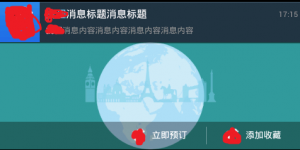Android推送通知(Notification)相关只是,直接从Android官方开发文档中就可以找到。本文记录的是一些官方开发文档中没有记录到的,但本人在开发过程中遇到的问题。
基本思路:推送是应用公用的通用空间,需要尽可能通用化。自定义RemoteViews,用接受到的json数据来填充要显示的内容,将所有事件用Broadcast发送出去。下面一件件来说明这个过程中遇到的问题,极其对应的解决方案。
1. RemoteViews的自定义,虽然PM的要求通常可能会有些天马行空,但是实现的时候还是需要尽量做到简洁,实现同样的功能,没有BUG的理想情况下,总归是代码的行数呈现了其质量
2. 下面这种Notification的实现,一般可能需要定义两个RemoteViews。因为这种信息可以合并起来。合并起来的时候和系统自带的差不多。其实就是两个RemoteViews之间的切换。收起来的时候显示contentView,展开之后显示的是bigContentView

notify.contentView notify.bigContentView
- 显示丰富色彩的TextView,方案不只一种,但根据自己的喜好,简单方便程度我选择了用Html来标记色彩的方式
<html>
<body>
<p><font color=\"#80d9ff\">蓝色</font>标题的推送消息</p>
</body>
</html>
Html.fromHtml(this.title)
4. RemoteViews中的元素上添加事件,因为推送是公用的,所以事件具体要处理的内容也是不固定的。所以我选择了将事件以广播的方式发送出去。这里有一点需要注意的是,RemoteViews中元素上添加事件发送广播,广播的Intent必须用Component指定接收类的class,否则广播无法发送成功。
Intent intent = new Intent(context, NotificationReceiver.class);
intent.setAction("com.android.view.receiver.NotificationReceiver");
intent.setData(Uri.parse(action));
intent.putExtra("notifyId", notifyId);
PendingIntent pendingIntent = PendingIntent.getBroadcast(context, (int) (System.currentTimeMillis() % Integer.MAX_VALUE), intent, PendingIntent.FLAG_UPDATE_CURRENT);
notify.contentView.setOnClickPendingIntent(R.id.notify_button, pendingIntent);
自定义的推送在点击View内部控件的事件之后,通知不会自动消失,需要手动控制,我的处理方式是把推送的id通过intent的putExtra传递给事件处理Reciver
通知栏不自动收起的问题,解决方法分两步:添加状态栏控制权限;用代码控制状态栏收起
<uses-permission android:name="android.permission.EXPAND_STATUS_BAR"/>
/**
* Collapse status panel
*
* @param context
* the context used to fetch status bar manager
*/
public static void collapseStatusBar(Context context) {
try {
Object statusBarManager = context.getSystemService("statusbar");
Method collapse;
if (Build.VERSION.SDK_INT <= 16) {
collapse = statusBarManager.getClass().getMethod("collapse");
} else {
collapse = statusBarManager.getClass().getMethod("collapsePanels");
}
collapse.invoke(statusBarManager);
} catch (Exception localException) {
localException.printStackTrace();
}
}